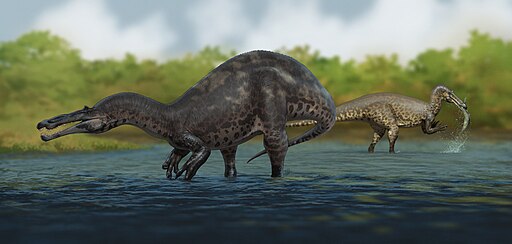The Crocodile Mimic
Suchomimus, meaning “crocodile mimic,” was a large theropod dinosaur that lived during the Early Cretaceous period, approximately 112 to 93 million years ago.

| Meaning | Crocodile mimic [Sucho–mimus] |
| Pronunciation | SOO-koh-MY-mus |
| When: | Early Cretaceous (about 125–112 million years ago) |
| Where: | Africa (Niger) |
| What: | Theropod (spinosaurid, piscivorous) |
| Weight: | Estimated around 3.6–5.2 metric tons |
| Length: | Approximately 11 meters (36 feet) |
| Diet: | Piscivorous (ate fish, possibly also small animals) |
| Discovered: | First described by Paul Sereno and colleagues in 1998 |
It belonged to the spinosaurid family, known for their distinctive crocodile-like appearance and adaptations for a semi-aquatic lifestyle.
Suchomimus was named for its long, narrow jaws filled with sharp, conical teeth, resembling those of modern crocodiles.
It had a streamlined body with powerful hind limbs and a long, robust tail, which may have helped it navigate through water and on land.
Suchomimus is estimated to have reached lengths of about 10 to 11 meters (33 to 36 feet) and weighed around 2 to 5 tons.
One of the most remarkable features of Suchomimus was the sail-like structure on its back, formed by elongated neural spines (bony projections from the vertebrae). This sail may have served multiple purposes, including thermoregulation, display during mating rituals, or even as a means of recognition among individuals.
Suchomimus was primarily a piscivore, meaning it primarily fed on fish. Its long, narrow jaws and sharp teeth were well-suited for catching slippery prey in rivers and lakes. Fossils of Suchomimus have been found in North Africa, specifically in Niger, where it lived alongside other dinosaurs and ancient crocodiles in a lush, river-dominated environment.
Its unique combination of features, including its crocodile-like skull and sail-backed structure, showcases the evolutionary experimentation that occurred among theropod dinosaurs during the Cretaceous period.
